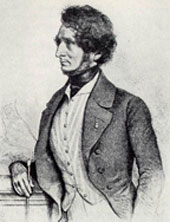Flash version here.
 Looking for a change from your
go-to classics? Take a cue from the
LSM team as we recommend listening alternatives to the usual masterworks.
Looking for a change from your
go-to classics? Take a cue from the
LSM team as we recommend listening alternatives to the usual masterworks.
The masterwork:
Hector Berlioz’s Symphonie fantastique, Op. 40
Eighteen-thirty saw a great upheaval with France’s July Revolution.
That same year, French composer Hector Berlioz (1803-1869) won the Prix
de Rome, a prestigious prize that financed an artist’s studies for
five years. He also completed his Symphonie fantastique. Inspired
by literary works of Thomas de Quincey (Confessions of an Opium Eater)
and Victor Hugo (Le Dernier Jour d’un Condamné), this programmatic
work uses many compositional devices to tell Berlioz’s own story of
hopeless love through music. His use of an idée fixe, a technique
used to transform themes to tell a story, express a mood or idea, effectively
unites the five-movement work. Here, the idée fixe represents
the lover of a composer. In a drug-induced state, the composer dreams
that he has killed the object of his affection to then be decapitated
at the end of the fourth movement. Drama ensues and dreams turn to nightmares
in the fifth movement, the Dream of a Witches’ Sabbath. Deep church
bells and the Gregorian chant Dies irae (Day of Wrath) add to
an increasing sense of dread. A masterful orchestrator, Berlioz’s
command of instrumental colours and textures paints scenes of joy, wistfulness,
solitude, and frenzy. His Symphonie fantastique is a feast for
the ears and imagination.
Laura Bates
Alexandre Lazaridès’
essential Symphonie fantastique
Berlioz: Symphonie fantastique op. 14
New York Philharmonic/Leonard Bernstein
Sony SMK 60968 (69 min 13 s)
The “Fantastique” has been recorded
often, and by big names at that. Leonard Bernstein’s recording of May
27, 1963 does not demonstrate a talent for colours like the European conductors
who were part of a certain tradition; however, it has movement, passion,
life, and a March to the Scaffold that will make you shiver. He ignites his
orchestra, his direction then at its peak, and convinces us every time. Furthermore,
the sound recording is a remarkable.
Frédéric Cardin
recommends...
Ernest Chausson (1855-1899)
Symphony No. 1
Composed between 1889-1890
Similarities: a French symphony French,
of course, but with an expansive romantic character that is fiery at times. A rich
and sumptuous orchestration coloured with lyricism. A child of Berlioz no
doubt.
Differences: the symphony is
written in only three movements and does not use the scheme of the idée
fixe, so fundamental in the Fantastique. The chromatic harmony
also approaches the German symphonic style.
Essential Listening:
French Symphonies
Orchestre philharmonique de Radio France/Marek Janowski
Virgin Classics 61513 (2CD, 1998)
Éric Champagne
recommends…
Sergei Rachmaninoff (1873-1943)
Symphonic Dances, Op. 45
Composed in 1943
Similarities: Berlioz quotes
the Dies irae theme in the Dream of a Witches’ Sabbath, the infernal bacchanal that
ends his Symphonie fantastique. Rachmaninoff quotes the Dies
irae theme in several works including his Symphonic Dances, where
it appears in a finale that is close to the frenzied romanticism of Berlioz.
Differences:
While Berlioz’s Dies irae assumes gloomy and whimsical colours,
the Rachmaninoff recalls the eternal struggle of Eros and Thanatos. The
allusion that death lurks in a dance movement full of life confronts the desire
for life and death in a paradoxical delight: tragic and exhilarating, deeply
romantic.
Essential Listening:
Rachmaninoff: The Symphonies
Concertgebouw Orchestra/Vladimir Ashkenazy
Decca 455 798-2 (1998)
Paul E. Robinson
recommends…
Hector Berlioz (1913-1976)
La Mort de Cléopâtre
Composed in 1829
Similarities: Berlioz (literally)
wrote the book on orchestration and the Symphonie fantastique
is full of instrumental novelties (e.g. two sets of timpani, e-flat
clarinet, orchestral bells, col legno effects, etc.). La mort
de Cléopâtre is equally startling for the period.
Differences: As Cleopatra
is fatally bitten by the snake Berlioz has the two flutists switch to
piccolos for the only time in the symphony—to play four notes fortissimo!
Equally original is the depiction of death in the final pages. The double
basses (no doubling with cellos!) play the same 2-note figure no fewer
than 128 times in succession. The effect is truly hypnotic and otherworldly.
Essential Listening:
Berlioz: La Mort de Cléopâtre/Symphonie fantastique
Susan Graham, mezzo-soprano; Berlin Philharmonic/Simon Rattle
EMI Classics 5 099921 622403 (2008)
Hear Berlioz’s Symphonie fantastique
LIVE in concert:
• Royal Philharmonic Orchestra & the National Arts Centre
Orchestra/Zukerman in Ottawa; January, 17 2012. www.nac-cna.ca
• Orchestre symphonique de Montréal/Nagano; in Montreal: March 27,
29 & 31, 2012. In Quebec City: March 28, 2012. www.osm.ca
Translation: Laura Bates
Version française...

